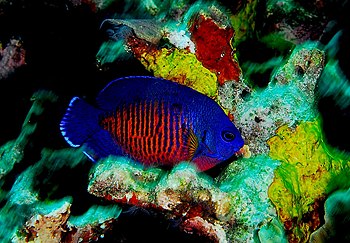 |
| Centropyge bispinosa (Photo credit: Wikipedia) |
This fish lives up to its name. Their heads, upper body region, and dorsal fin are bright blue or purple. This primary coloration fades into yellow or orange transitioning into a shade of pink at mid-body. Thin vertical banding of the primary body color breaks up this transition. Pectoral fins are typically orange or yellow. Anal and caudal fins are blue or purple. All but the pectoral fins are frequently outlined in neon blue. This species is also sold under the trade names Twospined Angel or Dusky Angelfish.
This is an excellent choice for amateur aquarists who want to own their first angelfish. They have all the exotic beauty one expects in a marine angelfish. They only grow to an adult length of 4 inches. So you don't need an enormous aquarium to house them. They can be raised in a tank as small as 30 gallons. Most angels carry a moderate to expert care level (depending on the informational source). Coral beauties are one of the hardiest angelfish. These fish have an easy care level so they are perfect for novice saltwater aquarium owners. Regardless of size, most angelfish are labeled as semi-aggressive. This species is among the most peace-loving of all angelfish. They may pick on smaller fish or fight with similar looking species as they mature but they do not demonstrate near the instinctive territorial behavior of most angels. More experienced aquarists will enjoy the fact that this species is rated reef safe if it is introduced to a marine reef environment as the juvenile and is well fed as an adult. All of these factors make the coral beauty one of the most popular and commonly kept angelfish in home aquariums.
This is an omnivorous species. Juveniles are primarily planktonic feeders. An adult's diet consists largely of algae. You will need to supply your aquarium with plenty of cured live rock to ensure the general health of any marine angelfish. Coral, crustaceans, mollusks, and worms comprise the remainder of an adult's dietary intake. This is why you want to introduce this species to a reef set up when they are still juveniles. The trick is to get them accustomed to aquarium food and algae as their total dietary intake before they develop their adult taste buds. Feeding should take place 2-3 times a day.
Like most angelfish, this is a hermaphroditic species. They are born of indeterminate sexuality. They will then develop into females. In a population consisting exclusively of females the largest, most dominant fish will undergo a hormonal change until it transforms into a male.
Coral beauties are one of the few marine species that have been known to breed in home aquariums. Breeding is induced by the release of a gamete, or sex cell, into the water. The gamete's presence will make this species feel the need to spawn. Spawning occurs shortly before dusk in their natural environment. In an aquarium, spawning is just as cyclic. Spawning will take place precisely one hour before the lights turn off in an aquarium with a timer. The fact that breeding habits make the transition into captivity is truly phenomenal.
Courtship begins with the male dashing around erratically in a pre-mating dance. Once the female is attracted, the perspective mates will then begin swimming side by side. The two will then seek out the most turbulent area in the aquarium. This is generally found next to the power head. The male will rub his nose against the female's side. The female will respond by expanding her fins in a seductive manner and then dashing off so as not to be thought of as an easy target for the male's affection.
Once the courtship rituals are completed, the female will release a small clutch of eggs (usually 12-20) one at a time for fertilization. The eggs are left to float away. Juveniles are platonic feeders. Fry must be fed newly hatched brine shrimp in order to increase their likelihood of survival.
Fish are not the only pets you can keep in an aquarium. Jellyfish Fish Tank Aquariums are the latest trend in aquarium ownership. Moon Jellyfish & Pet Jellies are some of the most exotic creatures you can keep in a home aquarium.
Article Source: EzineArticles
|

No comments:
Post a Comment